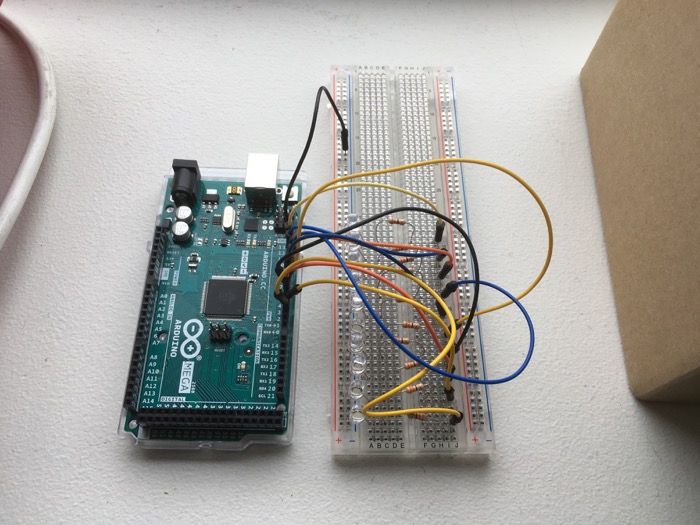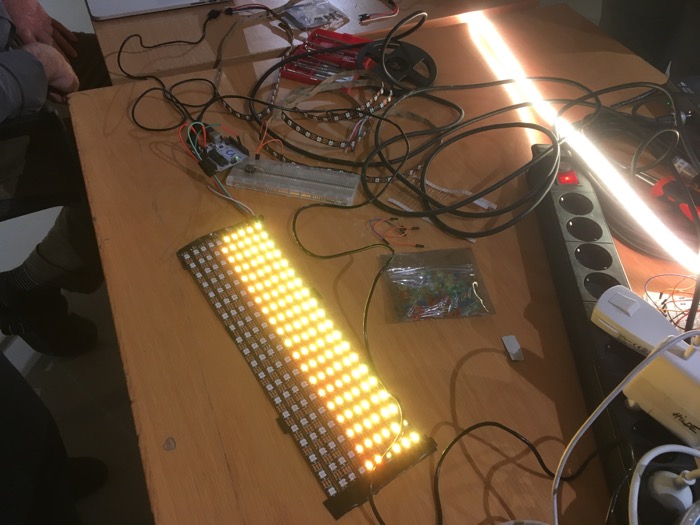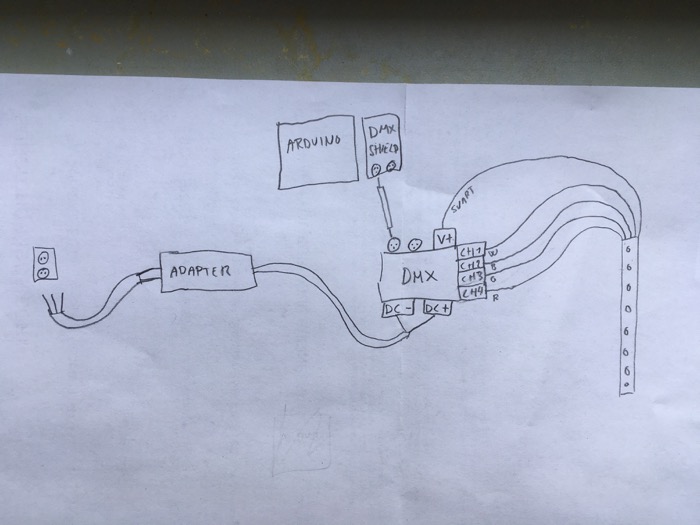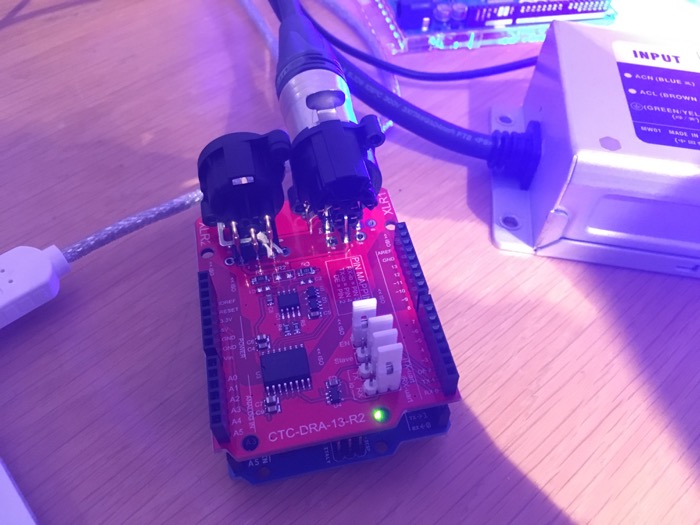LED - Strips and diodes
LED diodes
- To connect more LED diodes (not strips) than there is room for on an Arduino, you can use Arduino Mega or a shift register
LED strips
Neopixel Arduino library
- Look for addressable and/or Neopixel compatible LED-strip when buying to use with Arduino.
- LED strip requires external power adapter in Arduino
- Can also be used with Teensy
- FastLED is an alternative library for Arduino and Teensy.
- LED-strips can be daisy chained by using connectors or soldering. They can also be cut by scissor and soldered together.
- To use LED-strips with DMX and software like Madmapper, VDMX or Resolume Arena, you can use the Art-net protocol.
- Buy good quality LED-strips from China
LED strip and DMX
- DMX shield
- DMX library for Arduino
- Remember to change number of channels: #define DMX_MASTER_CHANNELS -> 4 <-
Built-in LED
void setup() {
// initialize digital pin LED_BUILTIN as an output.
pinMode(LED_BUILTIN, OUTPUT);
}
// the loop function runs over and over again forever
void loop() {
digitalWrite(LED_BUILTIN, HIGH); // turn the LED on (HIGH is the voltage level)
delay(1000); // wait for a second
digitalWrite(LED_BUILTIN, LOW); // turn the LED off by making the voltage LOW
delay(1000); // wait for a second
}
One LED diode
int led = 3;
int brightness = 255;
void setup() {
pinMode( led, OUTPUT );
}
void loop() {
analogWrite( led, brightness );
}
LED diode fading
int led[] = {3, 4, 5, 6, 7, 8, 9, 10, 11, 12};
int numOfLeds = 10;
int brightness = 0;
int fadeAmount = 1;
void setup() {
for ( int i = 0; i < numOfLeds; i++ ) {
pinMode( led[i], OUTPUT);
}
}
void loop() {
for ( int i = 0; i < numOfLeds; i++ ) {
analogWrite(led[i], brightness);
brightness = brightness + fadeAmount;
if (brightness <= 0 || brightness >= 255) {
fadeAmount = -fadeAmount;
}
}
delay(50);
}
Multiple LED diodes
int led[] = {3, 4, 5, 6, 7, 8, 9, 10, 11, 12};
int numOfLeds = 10;
void setup() {
for ( int i = 0; i < numOfLeds; i++ ) {
pinMode( led[i], OUTPUT);
}
}
void loop() {
// Her slukkes alle lys
for ( int i = 0; i < numOfLeds; i++ ) {
digitalWrite( led[i], LOW );
}
digitalWrite( led[0], LOW );
digitalWrite( led[1], LOW );
digitalWrite( led[2], LOW );
digitalWrite( led[3], LOW );
digitalWrite( led[4], LOW );
digitalWrite( led[5], LOW );
digitalWrite( led[6], LOW );
digitalWrite( led[7], LOW );
digitalWrite( led[8], LOW );
digitalWrite( led[9], LOW );
for ( int i = 0; i < numOfLeds; i++ ) {
digitalWrite( led[i], HIGH );
digitalWrite( led[i - 1], HIGH );
digitalWrite( led[i - 2], HIGH );
digitalWrite( led[i - 3], LOW );
delay( 500 );
}
}
LED-strip and button
#include "Adafruit_NeoPixel.h"
#ifdef __AVR__
#include "avr/power.h"
#endif
const int buttonPin = 52;
int buttonState = 0;
const int ledPin = 13;
const int numOfLeds = 60;
const int ledStripPin = 51;
Adafruit_NeoPixel pixels( numOfLeds, ledStripPin, NEO_GRB + NEO_KHZ800);
void setup() {
#if defined(__AVR_ATtiny85__) && (F_CPU == 16000000)
clock_prescale_set(clock_div_1);
#endif
pixels.begin();
pinMode(buttonPin, INPUT);
pinMode(ledPin, OUTPUT);
}
void loop() {
buttonState = digitalRead(buttonPin);
if ( buttonState == LOW ) {
digitalWrite(ledPin, LOW);
for ( int i = 0; i < numOfLeds; i++ ) {
pixels.setPixelColor( i, pixels.Color( 255, 0, 0 ) );
}
pixels.show();
} else {
for ( int i = 0; i < numOfLeds; i++ ) {
pixels.setPixelColor( i, pixels.Color( 0, 255, 0 ) );
}
pixels.show();
digitalWrite(ledPin, HIGH);
}
}
LED-strip DMX master
/*
DMX_Master.ino - Example code for using the Conceptinetics DMX library
Copyright (c) 2013 W.A. van der Meeren danny@illogic.nl. All right reserved.
This library is free software; you can redistribute it and/or
modify it under the terms of the GNU Lesser General Public
License as published by the Free Software Foundation; either
version 3 of the License, or (at your option) any later version.
This library is distributed in the hope that it will be useful,
but WITHOUT ANY WARRANTY; without even the implied warranty of
MERCHANTABILITY or FITNESS FOR A PARTICULAR PURPOSE. See the GNU
Lesser General Public License for more details.
You should have received a copy of the GNU Lesser General Public
License along with this library; if not, write to the Free Software
Foundation, Inc., 51 Franklin St, Fifth Floor, Boston, MA 02110-1301 USA
*/
#include "Conceptinetics.h"
//
// CTC-DRA-13-1 ISOLATED DMX-RDM SHIELD JUMPER INSTRUCTIONS
//
// If you are using the above mentioned shield you should
// place the RXEN jumper towards pin number 2, this allows the
// master controller to put to iso shield into transmit
// (DMX Master) mode
//
//
// The !EN Jumper should be either placed in the G (GROUND)
// position to enable the shield circuitry
// OR
// if one of the pins is selected the selected pin should be
// set to OUTPUT mode and set to LOGIC LOW in order for the
// shield to work
//
//
// The master will control 100 Channels (1-100)
//
// depending on the ammount of memory you have free you can choose
// to enlarge or schrink the ammount of channels (minimum is 1)
//
#define DMX_MASTER_CHANNELS 4
//
// Pin number to change read or write mode on the shield
//
#define RXEN_PIN 2
// Configure a DMX master controller, the master controller
// will use the RXEN_PIN to control its write operation
// on the bus
DMX_Master dmx_master ( DMX_MASTER_CHANNELS, RXEN_PIN );
// the setup routine runs once when you press reset:
void setup() {
// Enable DMX master interface and start transmitting
dmx_master.enable ();
// Set channel 1 - 50 @ 50%
dmx_master.setChannelRange ( 1, 25, 127 );
}
// the loop routine runs over and over again forever:
void loop()
{
static int dimmer_val;
// Keep fading channel 1 in from 0 to 100%
dmx_master.setChannelValue ( 1, 255 );
dmx_master.setChannelValue ( 2, 150 );
dmx_master.setChannelValue ( 3, 0 );
dmx_master.setChannelValue ( 4, 150 );
delay ( 100 );
}
LED-strip fade
#include "Adafruit_NeoPixel.h"
#ifdef __AVR__
#include "avr/power.h"
#endif
const int numOfLeds = 60;
const int ledStripPin = 51;
float fadeAmount = 0.5;
float brightness = 0;
Adafruit_NeoPixel pixels( numOfLeds, ledStripPin, NEO_GRB + NEO_KHZ800);
void setup() {
#if defined(__AVR_ATtiny85__) && (F_CPU == 16000000)
clock_prescale_set(clock_div_1);
#endif
pixels.begin();
}
void loop() {
for ( int i = 0; i < numOfLeds; i++ ) {
pixels.setPixelColor( i, pixels.Color( 255, 255, 255 ) );
}
brightness = brightness + fadeAmount;
if (brightness <= 0 || brightness >= 255) {
fadeAmount = -fadeAmount;
}
pixels.setBrightness( brightness );
pixels.show();
}
LED-strip snake
#include "Adafruit_NeoPixel.h"
#ifdef __AVR__
#include "avr/power.h"
#endif
#define PIN 51
#define NUMPIXELS 60
Adafruit_NeoPixel pixels(NUMPIXELS, PIN, NEO_GRB + NEO_KHZ800);
#define DELAYVAL 50 // Time (in milliseconds) to pause between pixels
void setup() {
#if defined(__AVR_ATtiny85__) && (F_CPU == 16000000)
clock_prescale_set(clock_div_1);
#endif
pixels.begin();
}
void loop() {
pixels.clear();
for ( int i = 0; i < NUMPIXELS; i++ ) {
pixels.setPixelColor( i, pixels.Color( 255, 255, 255 ) );
pixels.setPixelColor( i - 1, pixels.Color( 100, 100, 100 ) );
pixels.setPixelColor( i - 2, pixels.Color( 50, 50, 50 ) );
pixels.setPixelColor( i - 3, pixels.Color( 10, 10, 10 ) );
pixels.setPixelColor( i - 4, pixels.Color( 0, 0, 0 ) );
pixels.show(); // Send the updated pixel colors to the hardware.
delay( DELAYVAL ); // Pause before next pass through loop
}
}





